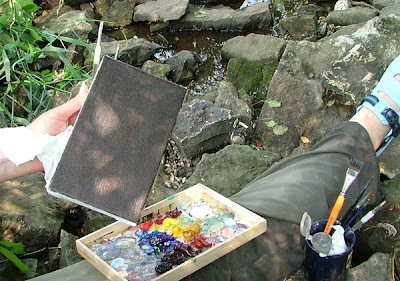Simplifying the Plein Air Studio
Welcome to my plein air studio. On 19 July it is in the Rideau River at Andrewsville. My setup is very simple - just a sturdy plastic caddy whose main space holds my tubes of paint, a pair of wooden boxes for palette and wet canvas, and the mug that holds my water. Under the outer flap of its lid are all my brushes. In my backpack are camera, mosquito coil, lunch, etc. I often carry a beach umbrella too, but the overhanging bushes shade this little plein air studio so I won't need the umbrella today.
Here is the caddy. Sometimes I take everything I need out of it and use it for a seat, but usually I sit on the ground, or on a rock or log. Occasionally I would like to stand to paint, and I used to carry an easel, but did not use it often enough to make carrying it everywhere worth while.
Here are the two wooden boxes. I bought them at Dollarama for $1.25 each. One I use for the 5 x 7 or 5 x 8 stretched canvas. You can see my blank canvas in the box. A scrap of sponge keeps it from rattling, and the upright nature of the caddy ensures that the wet painting doesn't get turned upside down. The other wooden box I turned upside down, and lined the lid with stiff, matte-textured plastic from a report cover, to use as a palette. It is stuck to the unfinished wood with double-sided scrapbooking tape, and I pry the plastic free with a palette knife when it needs to be soaked and scrubbed, replacing the tape to re-line the lid. I made two of these palette boxes, so I can switch directly to a clean palette.
First I choose a colour for the underpainting, scrubbing it into the texture of the gessoed canvas with a stiff brush. I give it a wipe with paper towel to remove extra paint from the surface and then scratch my composition in with the end of a brush.
Sometimes my painting session is cut short and I must fiish at home from my photos. I'm afraid that's going to happen today because the rest of our field party are nearly finished with their mussel collecting and we'll have to leave soon. So I begin with the foreground because I'm making some adjustments in the positions of the mussel shell and the rocks. According to the reference photo, the mussel shell would have been in the centre of the foreground, but I want it over on the left, offset to balance with the sunlit limestone of the old stone bridge footing. Getting this part established first makes sure that my painting does not depart from the essence of the subject - the elements in reality are here to speak to me while I make the alterations for the sake of my composition.
... and here I am putting the wet brushes away, having wrapped them in an old plastic bag. I usually coat them with brush cleaning soap in case I don't have a chance to wash them as soon as I get back.
We shall see in the next post, how the painting worked out - it always makes me nervous to leave a plein air studio with a substantial part of a painting unfinished. Wish me good luck!









Comments
Post a Comment
What do you think of this painting, and what do you know about the subject that I have painted?